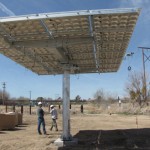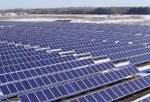Is PV a Viable Option for Sustainable Energy or an Academic Exercise?
Below are three stories about photovoltaic investments in the public and academic sectors that highlight two Sustainability disconnects that must be addressed. These are
- Is this “investment” wise and worth the expense?
- Is this action Sustainable?
Victor Valley College
The New York Times green blog reported in March 2010 that the nation’s first big concentrating photovoltaic power plant is under construction in the California desert. Victor Valley Collegein Victorville, CA a desert community hired SolFocus, to build the one-megawatt solar farm.
The blog reports that ” large solar panels contain small mirrors that concentrate sunlight onto tiny, high-efficiency solar cells. Though more expensive than conventional solar cells, they use a fraction of the silicon and produce more electricity. That means less land is needed …panels are mounted on trackers that follow the sun throughout the day. “
The solar power farm will supply about 30 percent of the college’s overall electricity demand by capturing sunlight, but the 122-panel farm consumes six acres at the college. The manufacturer claims that in desert regions, the company’s technology generates electricity at prices competitive with traditional photovoltaic panel. No pay back figures were available.
Further, a spokesperson for the manufacturer conceded “If this deployment had been in somewhere in Northern California or Washington or Oregon, we probably wouldn’t have won the battle”.
Colorado State University
In another academic exercise, CSU, is equipping its Foothills Campus Chrisman Field with a two megawatt solar power plant solar plant to feed more than 10 percent of the electricity energy needs on the Foothills Campus.
This plant consumes 15 acres and may be the largest at a US university. The project was made possible by a partnership with Xcel Energy and Fotowatio Renewable Ventures involving a long-term electricity contract known as a Power Purchase Agreement. According to the CSU web site:
- The plant capacity is 2 MWdc or 2,000 kWdc and has an annual output of 3.5 million kWh.
- This is enough energy to power almost 400 homes.
- Panels are manufactured by Trina Solar.
- There are 8,697 modules.
- Each panel has an output of 230 Watts and operates at 14% efficiency.
Los Angeles Unified School District (LAUSD)
In February LAUSD announced a $350-million program to put enough solar panels on schools and other district buildings to generate 50 megawatts of electricity (enough energy to power as many as 50,000 homes) by 2012 with the goal of reducing its $80-million annual electricity bill.
The problem is that this project, called “We Build Green” may cost taxpayers more money than it will ultimately save in energy use. LAUSD’s director of sustainability cites a savings of about $12.5 million a year for 20 to 25 years, for a maximum of about $320 million. This means that even with out present value / future worth considerations, the project still will not have paid for itself in 25 years – and this does not account for infrastructure and maintenance costs over the term.
Is this dive toward PV a cost justified and Sustainable?
That spokesperson in the Victor Valley College installation probably could have cited the rest of the US as inappropriate or PV farms since most of us do not live in the dessert and posses throw away wasteland to visually pollute with solar panels in order to appear to go green. The cost of the energy created is non dessert areas is presumably uncompetitive. The PV farm also ruins six acres of land that could be developed for other purposes.
The CSU land ratio is even worse, at 2 Mw over 15 acres. Note also the stunningly low energy efficiency rating of 14%.
The LAUSD contends that their program will also create jobs and provide enough of an economic stimulus to more than pay for itself. The chairman of the district’s school construction bond oversight committee is quoted as saying, “We are fighting for our economic lives,” What you are doing is absolutely essential, because we must become energy independent and, especially here in California, we must create our own jobs.”
Is it the best use of resources?
Photovoltaic energy is a green source but it has its limitations. Its dreadfully low efficiency will improve as technology matures. For now, would it be better to devote the solar energy to more efficient uses such as low level lighting, domestic hot water, and localized (such as exit and emergency lighting) rather than general lighting?
Rather than suffering negative payback, would it be better to invest in other alternative energy sources that do not consume as much in the way of resources? Then the real savings could be plowed into other ways to save. It is not the LAUSD’s job to create jobs; they should be concentrating on protecting the public investment. One way is to invest in real costs savings. Have they resolved all the facilities issues? Have all the HVAC efficiencies been harvested from the existing systems? It makes sense to plan on saving money right now and going green by saving energy. It makes no sense to plan on losing money for 25 years.
Sustainability requires us to make intelligent choices that conserve energy and capital all around, not just in isolated show case situations that are not easily or efficienlty replicated.



